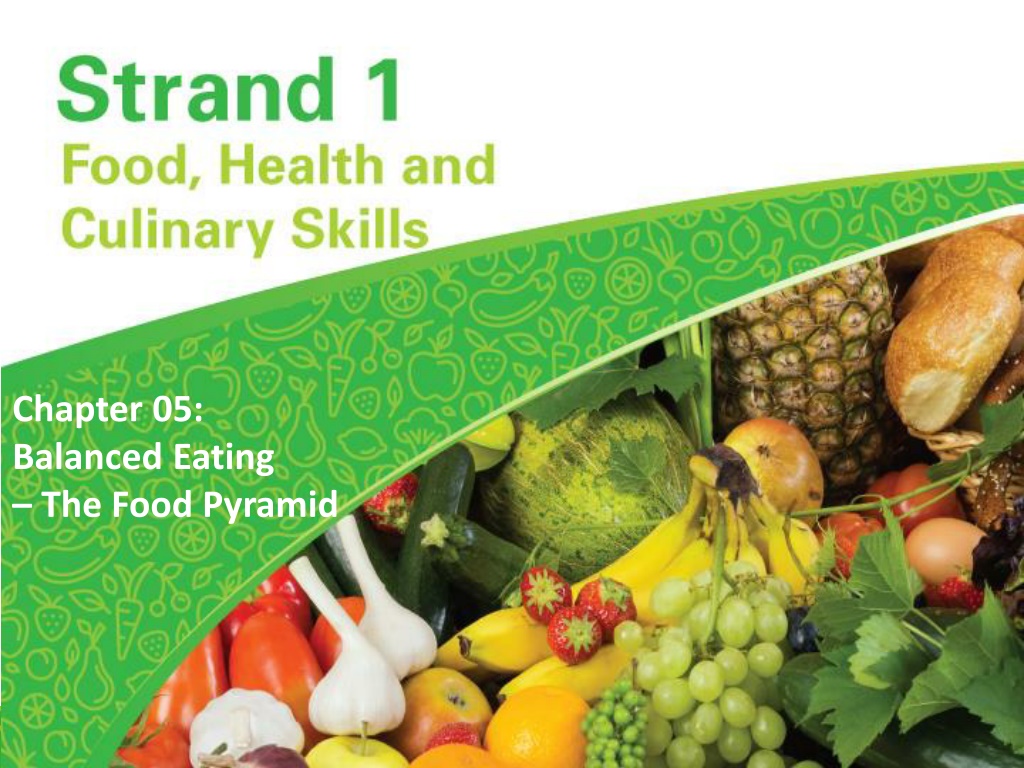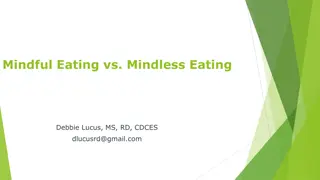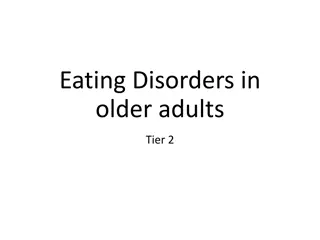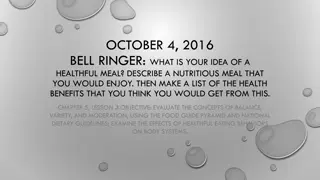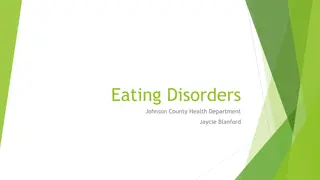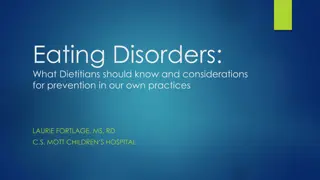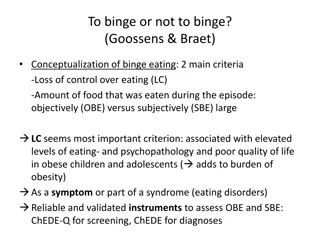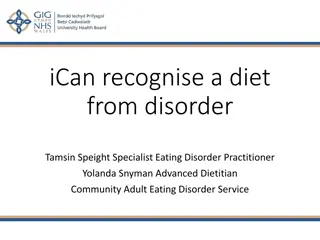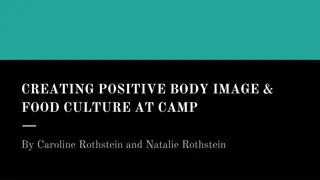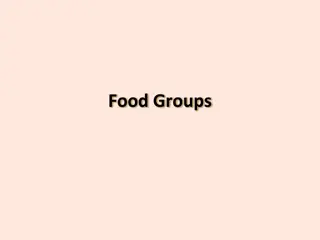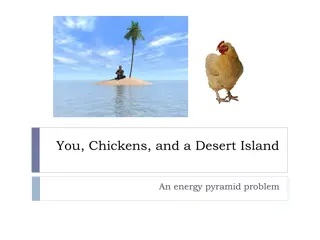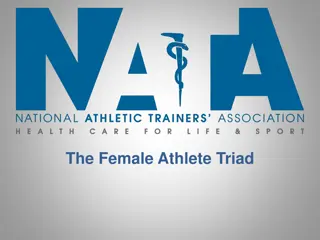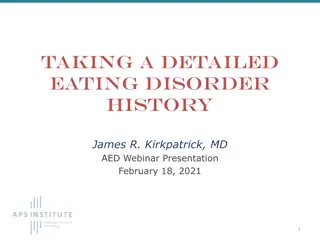Understanding Balanced Eating: The Food Pyramid
Explore the importance of balanced eating through the food pyramid, healthy eating guidelines, and key concepts such as food groups, nutrients, and meal planning. Learn how to create a nutritious diet that supports overall health and well-being by incorporating a variety of foods in appropriate portions. Discover the role of the food pyramid in promoting healthy choices and managing caloric intake for optimal nutrition.
Download Presentation

Please find below an Image/Link to download the presentation.
The content on the website is provided AS IS for your information and personal use only. It may not be sold, licensed, or shared on other websites without obtaining consent from the author. Download presentation by click this link. If you encounter any issues during the download, it is possible that the publisher has removed the file from their server.
E N D
Presentation Transcript
Chapter 05: Balanced Eating The Food Pyramid
What I Will Learn To describe the healthy eating guidelines To relate the food pyramid to meal planning
Key Words Balanced diet Food pyramid Serving Portion Composition Healthy Supplements
Healthy Eating Guidelines Nutritional research has shown that the type and amount of food a person eats has a huge impact on their health and general well-being. A balanced diet, combined with exercise, helps to ensure good health and reduce the risk of diet-related diseases. Healthy eating means getting the correct amount of nutrients protein, fat, carbohydrates, vitamins and minerals you need to maintain good health.
What is a Balanced Healthy Diet? It is important to follow the healthy eating guidelines and use the food pyramid to plan meals, to ensure your diet is balanced and nutritious. To have a balanced diet you need to combine several different types of foods from each of the main food groups in the right amounts. This will ensure your body gets all the nutrients it needs and maintains a healthy weight.
The Food Pyramid The food pyramid is designed to make healthy eating easier: Foods that contain the same type of nutrients are grouped together on each of the shelves. This gives a choice of different foods from which to choose a healthy diet. Using the food pyramid can guide you to get the right balance of nutritious foods within your calorie range. Studies show that we take in too many calories from foods and drinks that are high in fat, sugar and salt (found on the top shelf of the food pyramid). These provide a lot of calories with little nutrients, so limiting these is essential for healthy eating.
Food Groups in the Pyramid There are six food groups on the pyramid: Vegetables, salad and fruit Wholemeal cereals and breads, potatoes, pasta and rice Milk, yoghurt and cheese Meat, poultry, fish, eggs beans and nuts Fats, spreads and oils Foods and drinks high in fat, sugar and salt
Vegetables, Salad and Fruit Provide fibre. Provide many important vitamins and minerals and are low in calories. Provide vitamin C to help our bodies heal cuts and bruises and fight infection too! Provide vitamin A, which helps prevent diseases and keeps our skin healthy. Choose at least five to seven servings a day.
Vegetables, Salad and Fruit (continued) Watch the YouTube video on this food group from safefood.eu
Wholemeal Cereals and Breads, Potatoes, Pasta and Rice Foods on this shelf are the best energy providers. The healthiest starchy foods are those that are high in fibre, e.g. brown rice, wholemeal pasta and wholegrain bread instead of white rice, white pasta and white bread. Wholegrain breakfast cereals (including porridge) and baked potatoes eaten with their skins also provide fibre. Choose three to five servings a day. Up to seven servings for teenage boys and men aged 19 50. Very active people will need more.
Wholemeal Cereals and Breads, Potatoes, Pasta and Rice (continued) Watch the YouTube video on this food group from safefood.eu
Milk, Yoghurt and Cheese Milk, yoghurt and cheese provide calcium, which is needed for healthy bones and teeth. Calcium is important during the teenage growth spurt and also for older adults. Foods on this shelf of the food pyramid, especially full-fat cheese, can be high in saturated fat, so choose lower fat cheese regularly. When choosing foods from this shelf, choose milk and yoghurt more often than cheese.
Milk, Yoghurt and Cheese (continued) Skimmed milk is not suitable for children under five. Low-fat milk is not suitable for children under two. If dairy products must be avoided, eat foods enriched with calcium and vitamin D. Vitamin D helps the body to absorb calcium. The typical Irish diet is low in vitamin D talk to your pharmacist or doctor about taking a supplement. Check your portion size against the servings listed in the food pyramid, e.g. 100 ml of milk counts as half a serving.
Milk, Yoghurt and Cheese (continued) Watch the YouTube video on this food group from safefood.eu
Meat, Poultry, Fish, Eggs, Beans and Nuts The foods on this shelf provide protein for growth and repair. They are also the main source of iron for healthy blood. Vary your choices. Choose lean meat trim excess fat from meat and remove skin from poultry. Limit processed meats such as bacon or ham, which are usually high in fat and salt.
Meat, Poultry, Fish, Eggs, Beans and Nuts (continued) Iron-rich foods such as red meat and egg yolks are important for children, teenagers and women. Having a food or drink rich in vitamin C (such as orange juice) with an iron-rich food will aid your body s absorption of iron. Try to have fish at least twice a week and oily fish at least once a week. Pregnant and breastfeeding women should limit their consumption of tuna to no more than one serving a week.
Meat, Poultry, Fish, Eggs, Beans and Nuts (continued) Other good sources of protein are beans and peas when eaten with wholegrain breads, rice or pasta. They are also fat-free. If you are a vegetarian and get your protein regularly from cheese, always choose lower fat cheeses. You do not need large amounts of meat and poultry to satisfy your nutritional needs. Check your portion size against the servings listed in the food pyramid, one egg counts as half a serving; 150 g of meat counts as two servings.
Meat, Poultry, Fish, Eggs, Beans and Nuts (continued) Watch the YouTube video on this food group from safefood.eu
Fats, Spreads and Oils Fats, spreads and oils provide essential fats but these are only needed in very small amounts. Choose low-fat and reduced fat spreads and oils such as rapeseed or olive oil (monunsaturated) instead of hard margarine, lard or butter.
Fats, Spreads and Oils (continued) To have a low level of saturated fat, which is very important for your heart, limit butter to once a week. Mayonnaise and oil-based salad dressings also count towards your oil intake. Choose lower fat options. All oils contain the same amount of calories, so measure out the oil don t just pour it onto the pan.
Fats, Spreads and Oils (continued) Watch the YouTube video on this food group from safefood.eu
Foods and Drinks High in Fat, Sugar and Salt Foods on this shelf of the pyramid should be avoided as they are high in fat, including saturated fat, sugar and salt. They may promote obesity, which can lead to heart disease, Type 2 diabetes and some cancers. There are NO recommended servings for this group because they are not essential.
Foods and Drinks High in Fat, Sugar and Salt (continued) Watch the YouTube video on this food group from safefood.eu
Group Activity: Food Pyramid Poster For homework: You must investigate the foods on your level and gather images of them or draw images. You could also find out the nutrients this level contains and how many servings you need. You should give examples of serving sizes from your level. See pages 72 73 in the TRB
Food Pyramid Poster: In Class Take your blank section of the food pyramid Add all your information Assemble the food pyramid on the topic wall, level by level Evaluate the finished poster
Summary Healthy eating involves eating: Plenty of vegetables, salads, and fruit A serving of wholemeal cereals and breads, potatoes, pasta and rice at every meal choose wholegrain varieties wherever possible Some milk, yoghurt, and cheese Some meat, poultry, fish, eggs, beans and nuts A very small amount of fats, spreads and oils A very small amount or no foods and drinks high in fat, sugar and salt
